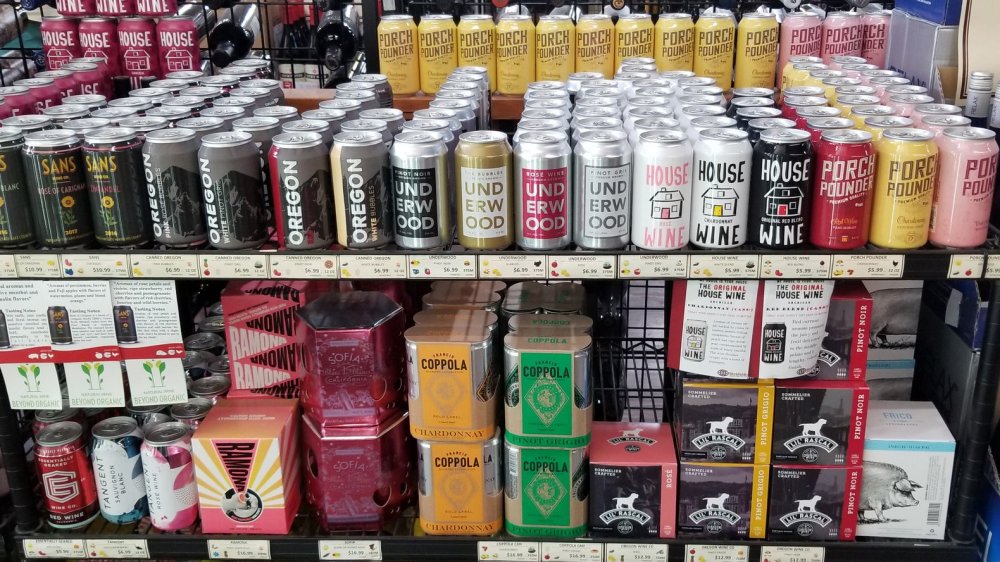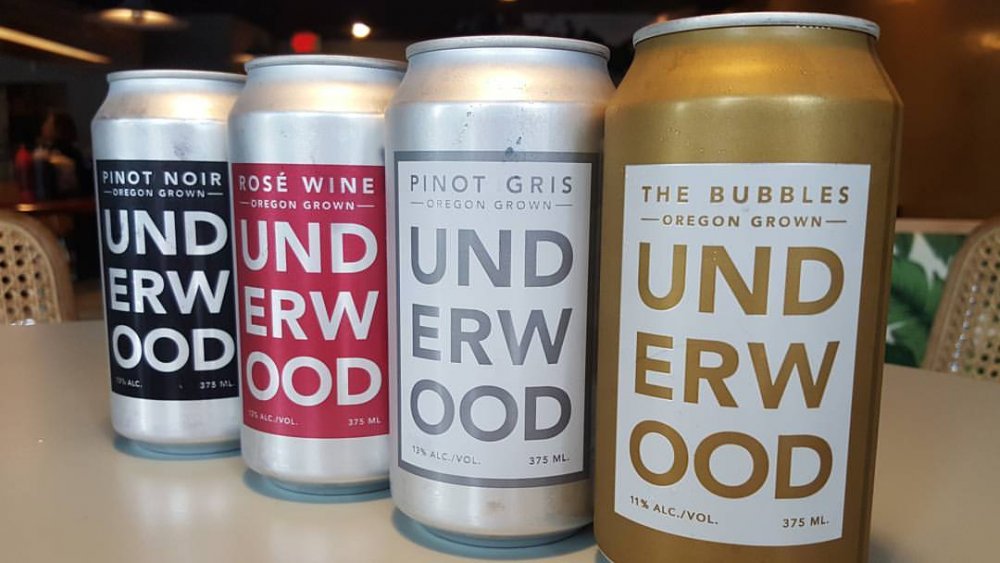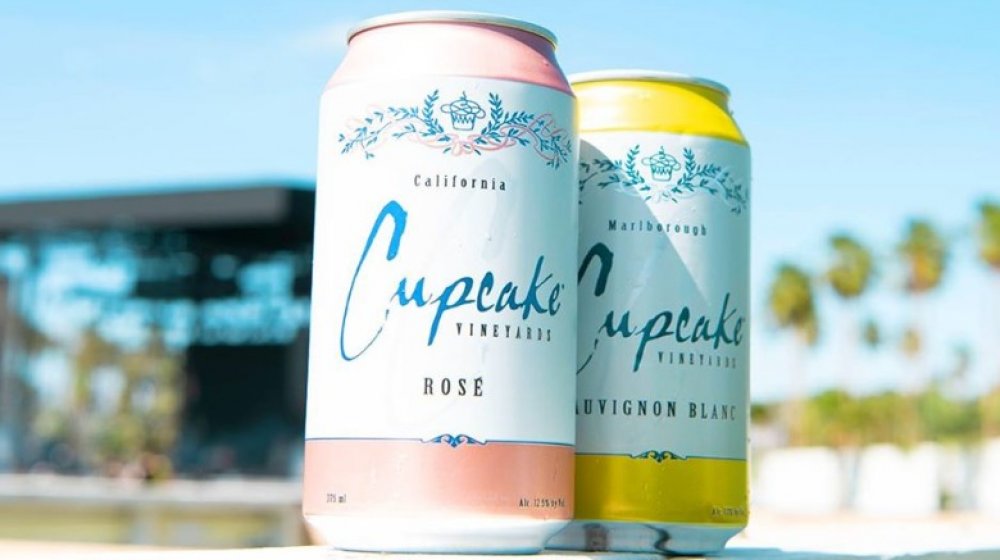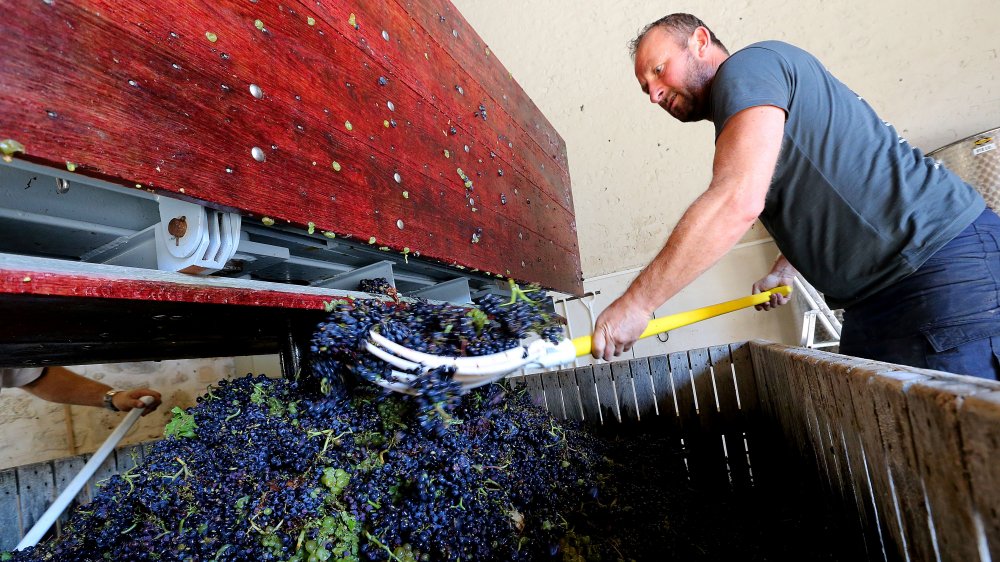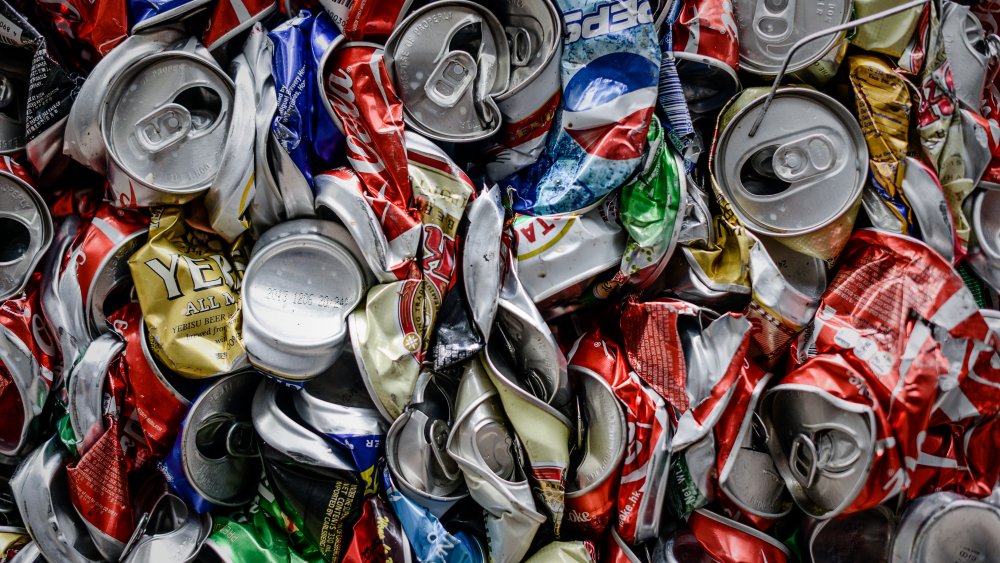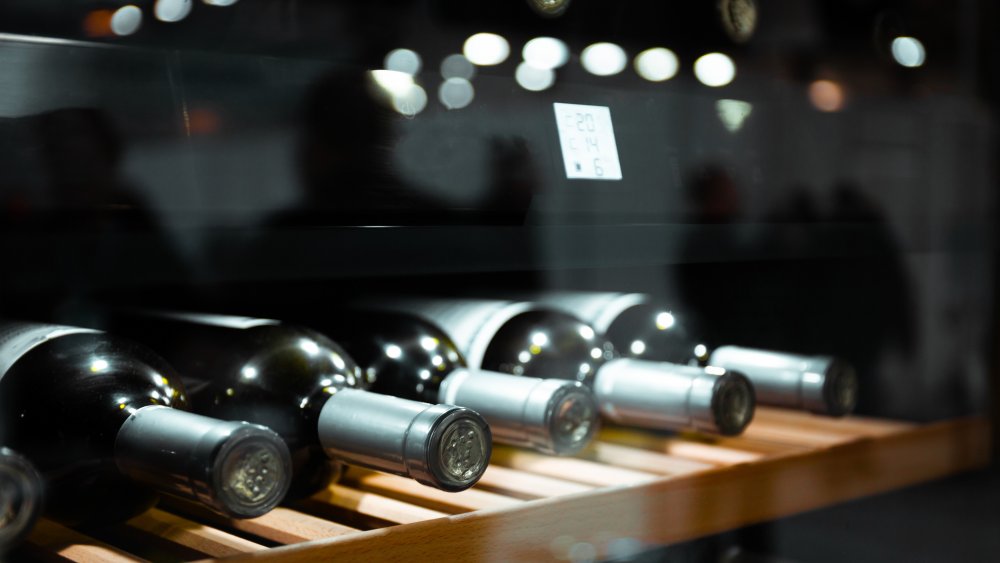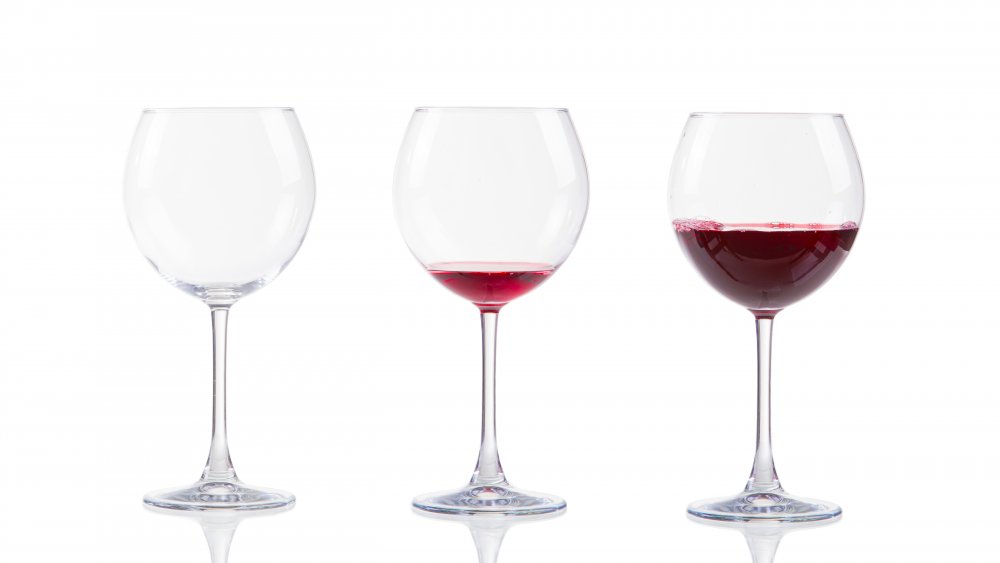The Truth About Canned Wine
Imagine going on a hike or heading out for a picnic and being able to bring a great wine along with you. Sure, you could bring a bottle and pair it with a few glasses and be on your merry way. But by the time you think about how to secure all of the glass — and don't you dare forget your bottle opener — it's all a little much.
Wine in the bottle, as it has been for hundreds of years, definitely has its place at the table, but its new cousin is on the scene, and canned wine doesn't seem to be going anywhere.
It's a popular sector of the industry that's only growing, and as consumers catch on, even more wineries are heading toward the canning line. But what exactly is the difference? Are canned wines and bottled wines the same? We took a deeper dive to find out more. This is the truth about canned wine.
Canned wine has been around longer than you think
As you stroll down the beverage aisle, it's liquors, beers, and hard seltzers as far as the eye can see. But if you're really paying, things are certainly changing in the cold can selection. There are more cans of wine on display next to seltzers and beers, and cans even have their own shelf in the wine section at some stores. And although this may seem like a new phenomenon because of how quickly the concept is catching on, canned wines aren't entirely new.
According to Marketwatch, The Family Coppola, a winery based in Geyserville, California, was the first winery to debut mini canned wines in the US in 2003. They hit the market with 187-milliliter cans with straws attached for their Blanc de Blancs, but the whole concept was pretty slow to catch on. It's been quite a few years since the mini can's first debut, but The Family Coppola kept at it, and still offers canned wine, now in other sizes and varieties, as well.
Canned wine is now a booming industry
When The Coppola Family first debuted canned wine in the U.S. in 2003, it was largely ignored by both consumers and the rest of the wine industry. But that all changed in 2014.
According to Wine Spectator, Union Wine Co. was a major player in kicking off the canned wine movement happening today. Union introduced its Underwood Pinot Noirof and Pinot Gris wines, which they canned in 375-milliliter cans, the same size as half of a bottle of wine. Once they introduced their canned option, Underwood's production of canned wines increased, with 55 percent of its wines being sold in cans.
The trend Underwood experienced is the same other wineries turning to cans began to experience as well. According to Forbes, a report from an alcohol market research firm stated that canned wine is only 2 percent of the wine category, but it's certainly growing. Sales of canned wines increased 43 percent from June 2017 to June 2018, and sales and popularity have been near doubling every year.
Canned wine is made the same as bottled wine
The wine-making process is one that takes precision and expertise.
Grape varietals are picked at the ideal timing and ripeness, destemmed, and then pressed to begin the time-consuming task of making wine. Depending on whether a white or red is being made, yeast is introduced at a specific time in the process to begin fermentation, which ultimately is what turns sugar into alcohol to give you that buzz.
Throughout the process, a winemaker may also decide to age the wine in barrels made of oak, stainless steel, or other materials, for a specific period of time to achieve certain flavor characteristics.
And while canned wine may seem like it has gone through an entirely different process, just because of the container it finds its way into, it is actually made just the same.
Director of winemaking at Union Wine Co., JP Caldcleugh, told SevenFifty Daily that they put the same exact same wine in bottles that they do in a can. A winemaker may determine certain types of wine are better for cans than others, but the actual process of making the beverage remains just the same.
Not all wines perform well in a can
While it may seem like cans are the best convenient option for wine drinking, you may not be getting exactly what you want if you're always choosing to drink from a can.
There's a reason wine has been bottled for hundreds of years, and sometimes, the wine just isn't meant to be canned. A winemaker could absolutely make a batch of wine and separate it between the bottling and the canning line to offer both options, just as Underwood Wine Co. does, but if there are certain characteristics of the wine that the winemaker wants to hold on to, it may not fare as well in a can.
According to Sevenfifty Daily, the grape varieties you utilize for canned wine matters. Wines that are a bit brighter, fruitier, aromatic, and even playful do much better when canned. Robust, complicated reds, or those that have seen oak, do not.
While most whites do well in a can because they're a bit more acidic and playful, an oaked, buttery chardonnay wouldn't pair as well with the clean, crisp essence of the can. A rosé performs well, again, because it does not feature harsh tannins or oak, but an oak-aged tempranillo would not perform as well simply due to its complex flavor profile.
This is why you see a lot of one type of wine in a can, and little to none of another.
Canned wine may be better than bottled for one reason
Whatever you decide about the aesthetics of cans versus bottles, or even how it affects the flavor, cans may, in fact, be better for the environment.
Yes, both glass wine bottles and aluminum cans are entirely recyclable, but is it easier to recycle one or the other? According to Forbes, a 2011 wine industry report stated that 80 percent of wine bottles end up in landfills rather than going to a recycling source.
That may be due to any number of factors, with the inconvenience of carrying heavy wine bottles being one of them, but according to Fortune, the process of recycling cans versus bottles is a bit different as well.
Recycling aluminum doesn't require much energy, and cans are able to be recycled indefinitely. Cans are able to be recycled and used over and over again, making it so that most cans on shelves are actually 100 percent recycled.
And while glass is absolutely recyclable as well, consumers often find there are too many variables that hinder its ease, such as sorting glass by color,and removing labels, to really devote effort to it.
Canned wine isn't meant to be aged
For wine lovers or collectors, a conversation about a 1980 bottle of Cabernet Sauvignon is awe-inspiring. Often, a bottle of wine tells a story, capturing what was happening during that vintage, and those bottles may be worth holding on to for that special date you're waiting to drink it.
But according to VinePair, most of the wine you'll find on store shelves is not actually meant to be aged, and a lot of that depends on the type of wine.
Typically, the price may give you a heads up if the wine is meant to be aged or consumed immediately, along with the wine's color or varietal. A sauvignon blanc or moscato, or perhaps a rosé, typically isn't meant to be left in the bottle very long because of their bright, fruity quality. Which, according to some, means they don't need to be bottled at all.
According to Wine Spectator, canned wines should be consumed shortly after canning. The cans aren't designed to facilitate any type of aging, and most winemakers are making these light options to be enjoyed during the year the wine is released.
The nose isn't the same on a canned wine
Examining the nose on a bottle or glass of wine is one of the main attractions of drinking wine. Because smell is one of the most primitive senses, the nose on a wine can completely change the feeling when someone drinks it.
According to Decanter, wine has over 900 potentially recognizable aromatic compounds. These aromas come from multiple phases of the process, from the grapes themselves to how the wine is aged. Each part of the winemaking process can add nuanced aromas, changing the nose of the wine. And anything from stainless steel aging to where the grapes were grown can sometimes be recognized.
But that isn't necessarily the case for canned wine. According to Wine Folly, the aromatics that may have once been in the wine can be completely changed, all thanks to the can. They say the can may ruin that initial fruit profile of each wine, and they're better served in glass if you would still like to enjoy the aromas.
One can of wine may equal more than one glass
Sitting down with a bottle of wine can be a little tricky. Once you select your option, spend 20 minutes hunting for your corkscrew, and then finally get the cork out to pour that glass, it can seem like a daunting task. But, once that bottle is finally cracked open, a consumer will always know they are opening 750 milliliters of wine — as long as you're dealing with a standard bottle. But with cans, the measurements aren't quite the same.
When The Family Coppola first came on the market, they were serving up 187-milliliter cans, or the equivalent of just over one glass of wine.
Next, Underwood came on the market with their 375-milliliter cans, equivalent to 2.5 glasses of wine.
Since then, really any size goes, with a 500-milliliter can, which contains over three glasses, or two-thirds of a standard bottle, to smaller 250-milliliter cans with about 1.5 glasses of wine. And those aren't the only sizes available.
With a bottle it's much simpler to notice how much alcohol you're consuming, but cans may be tricking consumers into enjoying a bit heavier of a pour.
